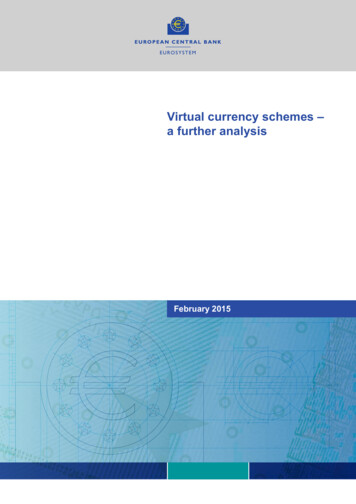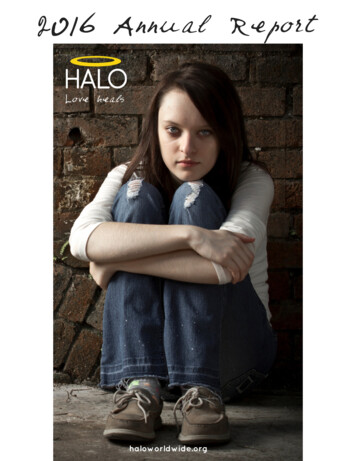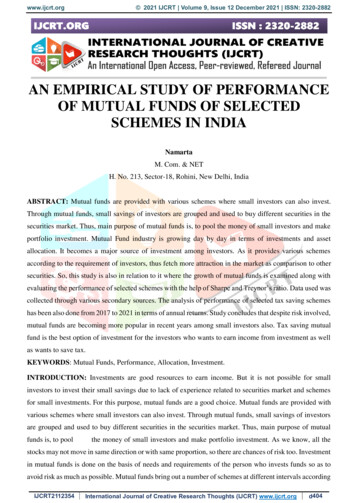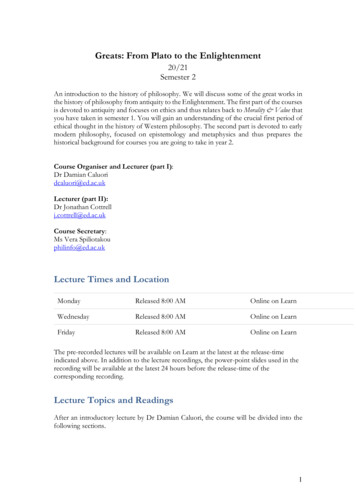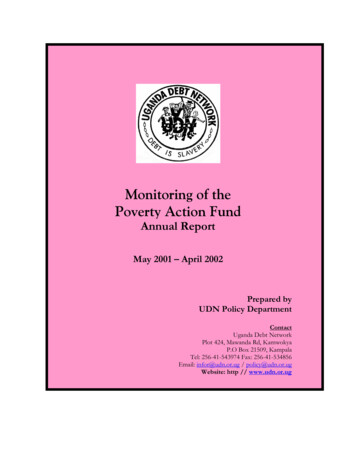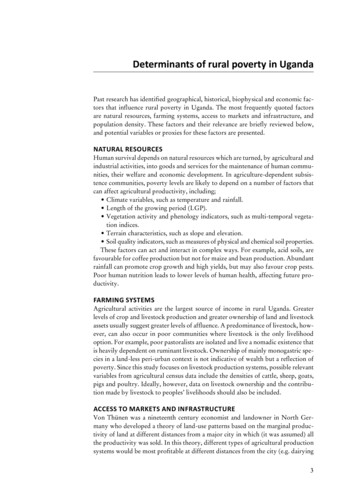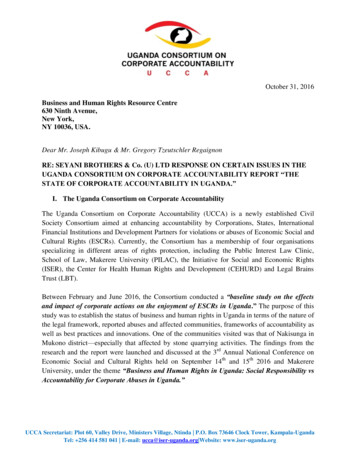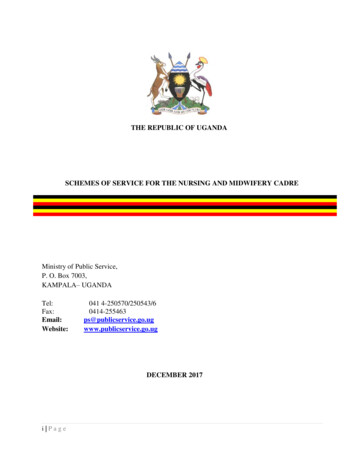
Transcription
THE REPUBLIC OF UGANDASCHEMES OF SERVICE FOR THE NURSING AND MIDWIFERY CADREMinistry of Public Service,P. O. Box 7003,KAMPALA– UGANDATel:Fax:Email:Website:041 www.publicservice.go.ugDECEMBER 2017i Page
TABLE OF CONTENTSLIST OF ACRONYMS . 11.0INTRODUCTION . 21.22.AIM AND OBJECTIVES. 42.12.22.32.42.52.63.NURSING AND MIDWIFERY FUNCTIONS . 3AIM . 4SPECIFIC OBJECTIVES. 4GUIDING PRINCIPLE . 4PROFESSIONAL GROWTH AND ADVANCEMENT . 4CAREER PROGRESSION . 5COST EFFICIENCY AND EFFECTIVENESS . 5ADMINISTRATION AND MANAGEMENT OF THE SCHEME. 53.13.23.33.43.53.63.7STAFF PERFORMANCE . 6MANAGEMENT GUIDELINES OF THE SCHEME OF SERVICE. 6IMPLEMENTATION OF THE NURSES AND MIDWIVES SCHEME . 6CREATION OF POSTS . 6RECRUITMENT AND PROMOTION . 6DEPLOYMENT AND STAFF ROTATION . 7TRAINING . 74.EXISTING NURSING AND MIDWIFERY GRADING QUALIFICATIONS AND CAREERPROGRESSION IN PUBLIC SERVICE . 84.14.2RECOGNIZED QUALIFICATIONS . 8CURRENT ESTABLISHED POSITIONS, EDUCATION REQUIREMENTS AND DEPLOYMENT . 95.RECOMMENDED NURSING AND MIDWIFERY POSITIONS, QUALIFICATIONS AND CAREERPROGRESSION IN PUBLIC SERVICE . 115.15.25.35.46.EDUCATIONAL PROGRAMS AND QUALIFICATIONS . 11REVISED GRADING AND CAREER PROGRESSION FOR THE NURSING AND MIDWIFERY CADRE . 12CONVERSION OF NURSING OFFICERS . 15COMPREHENSIVE NURSES . 15JOB DESCRIPTIONS AND PERSON SPECIFICATIONS . 16COMMISSIONER NURSING AND MIDWIFERY SERVICES . 16ASSISTANT COMMISSIONER NURSING . 19ASSISTANT COMMISSIONER MIDWIFERY . 22ASSISTANT COMMISSIONER PUBLIC HEALTH NURSING . 25ASSISTANT DISTRICT HEALTH OFFICER (MCH) . 28PRINCIPAL NURSING OFFICER (NURSING) . 31SENIOR NURSING OFFICER . 34NURSING OFFICER (NURSING) . 37PRINCIPAL NURSING OFFICER (MIDWIFERY) . 40SENIOR NURSING OFFICER (MIDWIFERY) . 43NURSING OFFICER (MIDWIFERY). 46PRINCIPAL PUBLIC HEALTH NURSE . 49SENIOR PUBLIC HEALTH NURSE . 52ASSISTANT NURSING OFFICER. 55SENIOR ENROLLED NURSE . 58SENIOR ENROLLED MIDWIFE . 61SENIOR ENROLLED PSYCHIATRY NURSE . 64ENROLLED NURSE . 67ENROLLED MIDWIFE. 70ii P a g e
ENROLLED PSYCHIATRIC NURSE . 73iii P a g e
LIST OF ACRONYMSBSc NBachelors of Science in NursingBSc MBachelors of Science in MidwiferyCPDContinuous Professional DevelopmentGoUGovernment of UgandaDHTDistrict Health TeamDPsDevelopment PartnersECNEnrolled Comprehensive NursesFPFamily PlanningHCHealth CentreHPCHealth Proffesional CouncilHTIHealth Training InstitutionHMISHealth Management Information SystemHP&EHealth Promotion and EducationHSCHealth Service CommissionGHsGeneral HospitalsLGsLocal GovernmentsMDAsMinistries Departments and AgenciesMoLGMinistry of Local GovernmentMoFPEDMinistry of Finance, Planning and Economic DevelopmentMoHMinistry of HealthMoPSMinistry of Public SrrviceMDAsMinistries, Departments and AgenciesMScMaster’s DegreeNRHNational Referral HospitalNGOsNon-Governmental OrganisationsU NMCUganda Nurses and Midwives CouncilPGDPost Graduate DiplomaPGQPost Graduate Qualification ( Masters or Diploma)RRHRegional Referral Hospital1 Page
1.0INTRODUCTIONThe Uganda Nurses and Midwives Act (1996) section 2 defines a nurse and a midwife as “personstrained and qualified in the promotion of health, prevention of disease and care of the sick andregistered or enrolled under section 24 of the same Act”. A nurse or midwife therefore providesholistic care which involves physical, psychological, social and spiritual care."A midwife" is a person who having been, admitted to a midwifery education programme hassuccessfully completed the prescribed course of studies, acquired the necessary qualifications and isduly recognized by the appropriate regulatory body, registered and licensed to practice midwifery;"A nurse" is a person who having been, admitted to a nursing education programme has successfullycompleted the prescribed course of studies, acquired the necessary qualifications and is dulyrecognized by the appropriate regulatory body, registered and licensed to practice nursing;The word nursing is derived from the Latin word “nurture” which means to “nourish”. Since 2000B.C; nursing has been associated with care of people in need that is the sick, the helpless, the young,the injured or disabled. The history of midwifery in ancient times is somewhat difficult to trace,however, earliest recorded mention of midwives is contained in the books of Genesis and Exodus inthe Holy Bible.Nursing first started as a desire to keep people healthy as well as provide comfort, care and assistanceto the sick. While midwifery, is an ancient profession with a proud tradition of providing care forwomen and babies during pregnancy and child birth. This objective has been maintained over time.The practice of nursing and midwifery has evolved into a modern profession due to the changingcharacteristics of society. Florence Nightingale (1843- 1950) is recognized worldwide for hercontribution to modern nursing and midwifery and promotion of nursing training and patient care.In Uganda, Sir Albert Cook was the founder of medical work in the country. He arrived in Uganda in1879 with 12 recruits. During the first world- war (1914- 1918), the first healing and training centrein Uganda was established at Mengo. Due to the need for maternity services, Katherine Cook beganmidwifery training under the Uganda Medical Services in 1919 at Mengo. Later, nurses’ training atenrolled level was started and the first class of Nurses qualified in 1933.On April 12th 1956, the Uganda Nurses and Midwives Council was formed and took over theresponsibility for the training of all nursing personnel and regulation of nursing and midwiferystandards. This marked an administrative turning point in the growth of nursing in the country. In1961, a new course of registered general nursing commenced at Mulago School of Nursing andMidwifery for girls and boys who had Cambridge School Certificate of Ordinary level education witha credit in English and one of the science subjects. In November, 1967 Registered Midwifery coursewas also started at Mulago. Mental Health Nurse training was started at Butabika in 1960. In 1970 sand early 1980 s a number of development courses were introduced such as Nurse/Midwifery Tutors course, administration course , public health nursing , anaesthesia and ophthalmic skills.2 Page
The health sector reform including decentralization necessitated the need for a cost effective,multipurpose cadre of a nurse, capable of delivering the Minimum Health Care Package. The majorityof trained health personnel were deployed in the secondary and tertiary health facilities that are basedin urban areas and were responsible for providing mainly curative services. This meant that the ruralpopulation was left without access to services of trained health personnel. The introduction of theGovernment policy of establishing health centres at village, parish, sub-county and county levelsthroughout the Country reinforced the need to have multi-skilled health workers to provide the rangeof services intended at the health centres hence the introduction of Comprehensive Nursing cadrewho would provide basic promotive, preventive, curative and rehabilitative health care at lower levelhealth centres.Comprehensive Nursing courses at Registered and Enrolled levels were introduced in 1993 and 2003respectively and training of a Bachelor of Science in nursing (1993). The regrading of jobs in 2003,as a result of job evaluation exercise necessitated a review of the scheme of service for the nursingcadre in the Public Service. Since then a number of changes have been introduced in the nursingprofession.1.2Nursing and Midwifery FunctionsNursing and Midwifery is a profession that provides holistic care to the population. The key functionsof Nursing and Midwifery include advocacy, disease prevention, health promotion, health education,counselling, therapeutic care, co-ordination and collaboration, research, and administration.1.2.1 AdvocacyNurses and Midwives taking action that speaks in favour of clients make recommendations, argue fora cause, support, defend or plead on behalf of clients.1.2.2 Disease Prevention and Health PromotionNurses and Midwives ought to plan care that fosters every aspect of growth and development.1.2.3 Health EducationNurses and Midwives design learning experiences to help individuals and communities improve theirhealth by increasing their knowledge and influencing their attitudes.1.2.4 CounsellingNurses and Midwives pay attention to the emotional and psychosocial support to clients.1.2.5 Therapeutic CareNurses and Midwives institute prescriptions, provide nursing care, maternal child care,documentation and accountability for actions taken to restore health.1.2.6 Coordination and CollaborationEvery Nurse and Midwife collaborates and coordinates on the needs and interventions to meet thepatient’s needs.3 Page
1.2.7 ResearchNurses and Midwives carry out systematic investigations into the study into a health care problem inorder to come up with new knowledge or to validate existing knowledge for evidence based practice.1.2.8 Leadership and ManagementNurses and Midwives manage and account for resources, supervise arrangements and tasks neededto influence health care outcomes. Leadership is an ongoing and fluid process that requirescontinuous evaluation to be responsive to ever-changing healthcare challenges.2. AIM AND OBJECTIVES2.1AimThis scheme of service aims at streamlining the functions and requirements for the nursing andmidwifery professions in order to clearly delineate career development and progression for the nursesand midwives in the Public Service.2.2Specific Objectivesa) To provide for a clearly defined career progression necessary to attract and retain suitablyqualified nursing and midwifery personnel into the Public Service.b) To provide for well-defined job descriptions and person specifications with clear demarcation ofduties and responsibilities for all nursing and midwifery jobs.c) To promote nursing and midwifery as a profession.d) Provide for new cadres that were introduced to the profession.2.3Guiding PrincipleThe scheme of Service is based on the following principles:a) Professionalismb) Fairness and equityc) Efficiency and effectiveness.2.4Professional Growth and AdvancementA Nurse or Midwife is expected to grow professionally. This may be through:a) Up grading to improve on the current qualifications with courses leading to bachelors, mastersand PhD degreesb) Research and publication of relevant material in the various nursing and midwifery specialties4 Page
c) Evidence of continuous professional development which may take various forms ranging fromrefresher courses, workshops, mentoring and coaching.d) Evidence of continuous ethical and moral training to foster the required and acceptable attitudetowards clients, and colleagues in the entire nursing and midwifery professions.2.5Career ProgressionA Nurse or Midwife can advance to higher grades on the basis of the following conditions:a) Confirmation in appointment.b) Attainment of the necessary qualifications and competences in Nursing and Midwifery andrelevant work experience as prescribed in this Scheme of Service.c) Evidence of satisfactory performance exhibited by the nurse or midwife.d) Existence of a vacant post and wage bill upon acquiring the necessary qualification.2.6Cost Efficiency and EffectivenessA Nurse or Midwife must display specific and observable knowledge, skills and behaviours that areassociated with effective functioning of the nursing and midwifery professionsa) Behavioural competences describing the effective traits andattitudesb) Technical competencies that reflect skills and knowledge for provision of cost effectiveinterventions that meets the clients’ needs.3. ADMINISTRATION AND MANAGEMENT OF THE SCHEMEa) The primary responsibility for the proper and effective administration and management of thisscheme of service shall be the Permanent Secretary, Ministry of Health in collaboration with theHealth Service Commission and Ministry of Public Service.b) The scheme of services for Nurses and Midwives will be implemented by the respectiveResponsible Officers of the Local Governments (LGs), relevant line Ministries, Departments, andAgencies (MDAs).c) The schemes of service will apply to nurses and midwives in the Ministries, Departments,Agencies, Local Governments5 Page
3.1Staff PerformanceUpon deployment, the respective Responsible Officer shall have full responsibility for themanagement of the Nurses and Midwives. The Responsible Officer’s responsibility shall include:a) Management of the Nurses and Midwives day to day performance at workb) Performance planning, monitoring, performance appraisals, rewards and performanceimprovement.c) Pay, staff training, development and disciplined) Custody of personal and confidential records of the Nurses and Midwives.3.2Management Guidelines of the Scheme of ServiceThe general management guidelines shall be as follows:3.3Implementation of the Nurses and Midwives SchemeIn implementation of the scheme, the positions shall be re-designated to reflect the new titlesintroduced under the scheme.3.4Creation of PostsA scheme of service does not constitute an authority for creation of post(s). Any additional postsrequired under the new grading must be included in the Ministry’s establishment proposals forconsideration and approval by the Permanent Secretary Ministry of Public Service.3.5Recruitment and PromotionWhen filling a post that is provided for under the available wage bill for that financial year, the MDAswill directly declare the vacancies to the respective service commissions for filling. However, wherethere is no wage provision for filling the position in that financial year, the MDA shall declare thevacant post to the Ministry of Public Service for clearance.Serving Officers with the required qualifications, relevant experience and competences as prescribedin this Scheme of Service, shall be eligible for promotion following interviews with the relevantService Commission. Promotions will be on merit.Attainment of higher qualifications does not lead to automatic promotion. Upon attainment of higherqualifications, Nurses and Midwives will only qualify for promotion subject to the availability of thevacancies and the wage.6 Page
3.6Deployment and Staff Rotationa) Officers in MDAs will be deployed according to the available positions and need.b) In the case of Local Governments, the Responsible Officer will be responsible for the posting tovarious departments or sections as the case may be.c) Responsible officers shall ensure that Nurses and Midwives are rotated at least after every threeyears for purposes of exposing them to the different Nursing and Midwifery functional areas.3.7Traininga) Training will be initiated and financed by the respective Ministries, Departments, Agencies(MDAs) and Local Governments where the Officers will be serving. The MDAs and LocalGovernments will consult the Ministries of Health, Public Service and Education and Sports forprofessional and policy guidance.b) Newly recruited Nurses and Midwives and those transferred shall be oriented and inducted intothe service by the respective Ministries, Departments, Agencies and Local Governments.c) For professional training that is not available in the Country, arrangements should be made fortraining abroad; consistent with the needs of the work of the individual within available resources.d) The successful completion of relevant management and professional training will normally betaken into account in the promotion process. Long term training in the relevant field will attractannual salary increment in accordance with the Uganda Public Service Standing Orders.7 Page
4. EXISTING NURSING AND MIDWIFERY GRADING QUALIFICATIONS ANDCAREER PROGRESSION IN PUBLIC SERVICE4.1(a)Recognized QualificationsCertificate Level Educationi) Certificate in Enrolled Nursingii) Certificate in Enrolled Midwiferyiii) Certificate in Psychiatric Nursingiv) Certificate in Enrolled Comprehensive Nursing(b) Diploma Level Educationi) Diploma in Nursingii) Diploma in Midwiferyiii) Diploma in Psychiatric Nursingiv) Diploma in Paediatric Nursingv) Diploma in Public Health Nursingvi) Diploma in Palliative Care Nursingvii) Diploma in Comprehensive Nursing(c) Advanced/ Higher Diploma Level Educationi) Advanced Diploma in Paediatric Nursingii) Advanced Diploma in Public Health Nursingiii) Advanced Diploma in Palliative Care Nursing(d) Bachelor’s Degree Level Educationi) Bachelor of Science in Nursingii) Bachelor of Science in Midwifery(e) Master’s Degree Level Educationi) Masters of Science in Nursingii) Masters of Science in Midwifery8 Page
4.2Current Established Positions, Education Requirements and DeploymentThe table below represents the existing grading of the Nursing and Midwifery cadre:No.1.Current Nursing3.AssistantDistrictHealth ursingOfficer6.PrincipalPublic HealthNurseSeniorNursingOfficer7.8.Senior PublicHealth Nurse9 PageSalaryEducation RequirementScaleU1 SE Bachelor’s degree inNursing Masters in Nursing orMidwifery or Public Health PGD in Management orAdministrationU1E Bachelor’s degree inNursing Masters in Nursing orMidwifery or Public HealthNursing PGD in Management orAdministrationU2 SC Bachelor’s degree inNursing Masters in Nursing orMidwifery or Public Health PGD in Management orAdministrationU2 SC Bachelor’s degree inNursing Postgraduate qualificationin Administration orManagementU3 SC Diploma in Nursing andMidwifery Diploma in Administrationor and ManagementU3 SC Diploma in Public HealthNursingU4 SC Diploma in Nursing andMidwiferyU4 SC Diploma in Public HealthNursingLevel ofDeployment MoH MoHNRHs DistrictHealthOffice MoHNRHsRRHs MoHNRHsRRHsGHsRRHGH MoHNRHsRRHsGHsMoHNRHsRRHsGHs
Public HealthNurseNursingOfficerU4 SC U5 SC Diploma in Public HealthNursingDiploma in Nursing11.NursingOfficerMidwiferyU5 SC Diploma in Midwifery12.NursingOfficerPsychiatryU5 SC Diploma in lledMidwifeEnrolledNurseU6 Certificate in NursingU6 16.17.9.10.14.15. RRHsGHsHCIVNRHsRRHsCertificate in Midwifery NRHsRRHsU7 Certificate in NursingEnrolledMidwifeU7 Certificate in MidwiferyEnrolledPsychiatricNurseU7 Certificate in PsychiatricNursing NRHsRRHsGHsHCIVHCIIIHC IINRHsRRHsGHsHCIVHCIIIHC IINRHsRRHsGHsHCIV10 P a g e
5. RECOMMENDED NURSING AND MIDWIFERY POSITIONS, QUALIFICATIONSAND CAREER PROGRESSION IN PUBLIC SERVICE5.1a)Educational Programs and QualificationsCertificate Level Educationi)Certificate in Enrolled Nursingii) Certificate in Enrolled Midwiferyiii) Certificate in Psychiatric Nursingiv) Certificate in Enrolled Comprehensive Nursingb) Diploma Level Educationi)Diploma in Nursingii) Diploma in Midwiferyiii) Diploma in Psychiatric Nursingiv) Diploma in Comprehensive Nursingc)Advanced/ Higher Diploma Level Educationi)Advanced Diploma in Paediatric Nursingii) Advanced Diploma in Public Health Nursingiii) Advanced Diploma in Critical Care Nursingiv) Advanced Diploma in Oncology Nursingd) Degree Level Educationi)Bachelor of Science in Nursingii)Bachelor of Science in Midwiferye) Post Graduate Diploma Level Educationi)Child Health (Paediatric) Nursingii)Palliative Care Nursingiii) Midwiferyiv)Reproductive healthv)Cardio-Thoracic Nursingvi)Critical Care Nursingvii) Trauma and Emergency (Ambulatory) Nursingviii) Theatre Nursingix)Orthopaedic Nursingx)Neurology Nursingxi)Oncology Nursingxii) Nursing Education/ Health professions Education/ Medical Educationxiii) Neonatal Nursingxiv) Nephrology Nursingxv) Geriatric Nursing11 P a g e
xvi)xvii)xviii)xix)Psychiatric NursingInfectious Diseases NursingPublic Health NursingTransfusion Nursingf) Masters Level Educationi)Child Health (Paediatric) Nursingii)Palliative Care Nursingiii) Midwiferyiv)Reproductive healthv)Cardio-Thoracic Nursingvi)Critical Care Nursingvii) Trauma and Emergency (Ambulatory) Nursingviii) Theatre Nursingix)Orthopaedic Nursingx)Neurology Nursingxi)Oncology Nursingxii) Nursing Education/ Health professions Education/ Medical Educationxiii) Neonatal Nursingxiv) Nephrology Nursingxv) Geriatric Nursingxvi) Psychiatric Nursingxvii) Infectious Diseases Nursingxviii) Public Health Nursingxix) Transfusion Nursing5.2Revised Grading and Career Progression for the Nursing and Midwifery CadreNo.1)Position/ TitleCommissioner,Nursing andMidwifery Services12 P a g eSalaryScaleEducation, Experience and other DeploymentConsiderationsU1SE Bachelor of Science in Nursingor Midwifery Master of Science in Nursing orMidwifery Post Graduate Qualification ineither Administration,Management ( Diploma orMasters) or Health ServicesManagement 12 years’ relevant workingexperience 3 of which atAssistant Commissioner level MoH NRHs
Registered with UNMC andholds a valid practicing licence2)3)AssistantCommissioner,Nursing/ Midwifery/Public HealthU1EAssistant DistrictHealth Officer,Maternal ChildHealthU2 SC13 P a g e Bachelor of Science in Nursingor Midwifery Master of Science in Nursing orMidwifery Post Graduate Qualification ineither Administration,Management ( Diploma orMasters) or Health ServicesManagement 9 years’ relevant workingexperience 3 of which atPrincipal Nursing Officer level Registered with UNMC andholds a valid practicing licence MoH NRHs RRHsa) A Bachelor of Science degree ineither Nursing, Midwifery orequivalent from a recognizedUniversity/Institutionb) Postgraduate Qualification(Masters or Diploma) in HealthScience Management,Administration, Management orthe equivalent from arecognizedUniversity/Institution.c) Must be registered with UgandaNurses and Midwives Councilwith a valid practicing licence.d) Should have working experienceof at least six (6) years, three (3)of which should have been atSenior Nursing Officer level orequivalent position from areputable organization. DLGs
4) U2SCPrincipal NursingOfficer,Nursing/ Midwifery/Public Health5)Senior NursingOfficer,U3 SCNursing Officer,Nursing/ Midwifery MoH NRHs RRHs SpecializedInstitutions GHs DHO MoH NRHs RRHs SpecializedInstitutions GHs HC IVs Nursing/ Midwifery/Public Health6) Bachelor of Science in Nursingor Midwifery Post Graduate Qualification ineither Administration,Management (Diploma orMasters) or Health ServicesManagement 6 years’ relevant workingexperience 3 of which at SeniorNursing Officer level Registered with UNMC andholds a valid practicing licence U4 SC Bachelor of Science inNursing or Midwifery3 years’ relevant workingexperienceRegistered with UNMC andholds a valid practicing licenceBachelor of Science inNursing or MidwiferyRegistered with UNMC andholds a valid practicing licence MoH NRHs RRHs SpecializedInstitutions GHs HC IVsDiploma and Certificate Holders7)Assistant NursingOfficer, Nursing/Midwifery/ PublicHealth/ Psychiatry14 P a g eU5 SC Diploma in either Nursing,Comprehensive Nursing,Midwifery or PsychiatryRegistered with UNMC and holdsa valid practicing licence NRHs RRHs SpecializedInstitutions GHs HC IVs
HC III8)Senior EnrolledNurse, Nursing/Midwifery/PsychiatryU6 Certificate in either Nursing,comprehensive Nursing,Midwifery or Psychiatry3 years’ relevant workingexperienceRegistered with UNMC andholds a valid practicing licence NRHs RRHs SpecializedInstitutions GHsHC IVs9)EnrolledNurse, U7Nursing/ Midwiferyor Psychiatry5.3 Certificate in either Nursing,comprehensive Nursing,Midwifery or PsychiatryRegistered with UNMC andholds a valid practicing licence HC IVs HC IIIsHC IIsConversion of Nursing OfficersPersons employed in the Nursing Officers cadre and are currently holding diplomaqualifications, will in the interim be converted to job titles detailed in the table below. Theyaccordingly retain their salary levels on a “personal to holder” basis.5.4S/NCurrent Job TitleNew Job TitleSalary Scale1Senior Principal Assistant NursingOfficerPrincipal Assistant Nursing OfficerU2 SC2Senior Principal NursingofficerPrincipal Nursing officer3Senior Nursing officerSenior Assistant Nursing OfficerU4 SC4Nursing officerAssistant Nursing OfficerU5 SCU3 SCComprehensive Nursesa) Enrolled Comprehensive Nurses shall be employed as Enrolled Nurses.b) Registered Comprehensive Nurses sh
1.2 Nursing and Midwifery Functions Nursing and Midwifery is a profession that provides holistic care to the population. The key functions of Nursing and Midwifery include advocacy, disease prevention, health promotion, health education, counselling, therapeutic care, co-ordination and collaboration, research, and administration. 1.2.1 Advocacy


